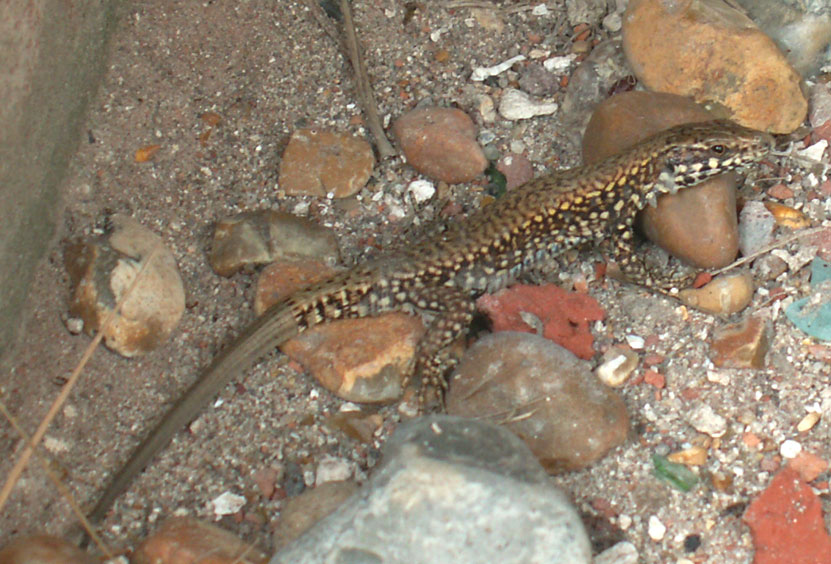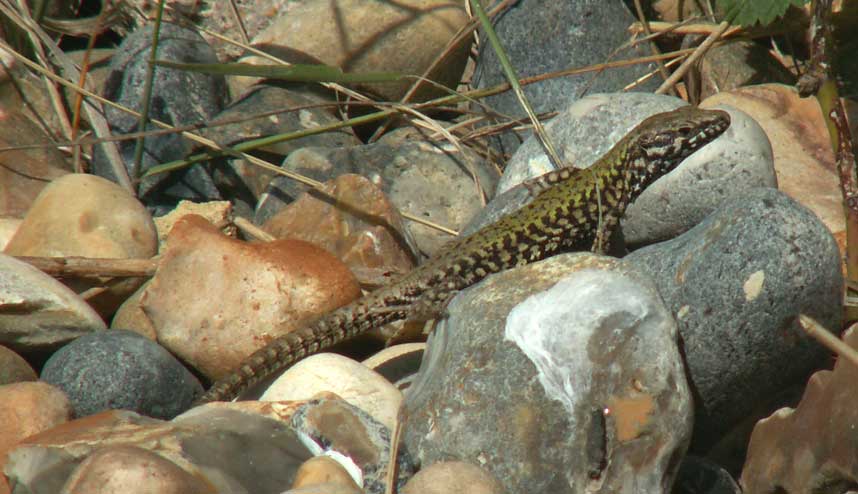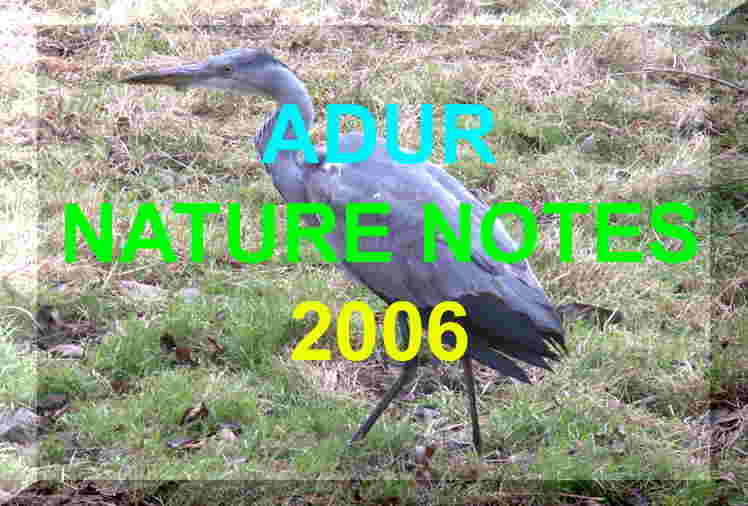Coastal
Zone
THE
ADUR SHORE
Shoreham,
Southwick and Lancing beach areas above High Tide mark
|
Overview
Shoreham
Beach is a shingle spit about three miles long, separated from town of
Shoreham-by-Sea (Sussex) by the River
Adur, which been has deflected eastwards by the
longshore
drift over the centuries. Wood and rock groynes have been installed
to stabilise the moving shingle and to minimise erosion and prevent flooding.
Wildlife
Reports
Link
to the Coastal Reports for 2007
19
December 2006

More,
about sixty, small Goose Barnacles,
Lepas
anatifera, were discovered on a piece
of wood stranded on Shoreham
Beach (Ferry Road).
14
December 2006
Thirty
Greenfinches
were seen on the shingle above high tide mark by Lancing Beach Green. Over
the intertidal area two separate Crows
were dropping shellfish from a height on to the pebbles below. The strandline
was littered with the usual mixture of mollusc
shells and seaweed and included lumps of lignite
(sea coal).
6 December
2006

A
Red-legged
Partridge was seen wandering around the
tiny paved gardens in Emerald Quay on Shoreham Beach. This bird wandered
around and did not fly off immediately.
Report
and Photograph by David Roberts (Shoreham Beach)
This
bird could have been displaced from New Monks
Farm, Lancing, where soil and rubble is being dumped on the privately
owned land to the west of Shoreham Airport. This
is speculation as my records show Grey Partridges
from that area.
29
November 2006
About
a hundred small Goose Barnacles, Lepas
anatifera, were seen washed up attached
to a broken plastic fish box on the strandline
of Shoreham Beach (Ferry Road access) after the recent southerly
gales.

This is
the first time I have seen them washed at Shoreham in over 25 years, but
I expect they have been washed up and unrecorded before on frequent occasions.
There
were the usual millions of Slipper
Limpet shells, frequent Whelk
and Mussel shells, seaweed
and cuttlebones etc.
BMLSS
Barnacles
A very
bright young Pipit
was seen close-up on the verges of the disused road and the toilets near
the Beach Huts on Shoreham Beach. This small brown brightly speckled bird
had pronounced speckled breast with no patches and fawn-grey coloured legs
before it flew upwards to a height of about four metres, called with a
little sqeak and was away showing its white tail feathers. This was certainly
a Meadow Pipit.
22
November 2006
A
flock of 13 Turnstones
were feeding on the seaweed strandline
at high tide on Shoreham Beach 30 metres or so
east of the Church of the Good Shepherd. They flew off in twos and threes
on my approach and then the whole flock twittered and flew in a semir-circular
route over the sea and on to the pebbled beach to the west of the rock
breakwater.
15
November 2006
A
flock of about fifty Greenfinches swooped over the pebbled beach
above the high tide mark next to Lancing Beach Green, and landed amongst
the Dock.
Construction
of the Sustrans path west of Lancing Sailing Club seems to have resulted
in the removal of the row of Tree Mallow
on the northern side. The Right of Way improvements may also have resulted
in the removal of Rock Samphire
to the east as well.
9 October
2006
A
Yellow
Wagtail visited a
flooded (temporary lagoon with seawater) in
a south Lancing garden (by Lancing Beach Green). (This,
perhaps, could have been a Grey Wagtail?)
Report
by Roy Bond
 28
September 2006 28
September 2006
There
were eleven Turnstones
foraging
on the strandline by the Old Fort on Shoreham
beach, dodging the waves as they came in on the high tide.
There were still a few flowers surprisingly a few clumps of Thrift,
Red
Valerian,
Sow
Thistle, Sea Campion and
Scentless
Mayweed with the umbellifer Yarrow
on the road verges. A small Common
Earwig was spotted on the Scentless
Mayweed.
4 September
2006
Two
Clouded
Yellow Butterflies were seen near
Lancing Sailing Club (west end of Widewater),
the second of these two immigrant butterflies
visiting a Common Mallow
and Dandelion
in quick succession. The only other butterflies on the beach seen were
Large
Whites.
Butterfly
Report
A Rabbit
under the beach Huts by Lancing Beach Green was seen with healthy eyes
and devoid of any illness.
24
August 2006
The
frequent Large Whites
fluttering around the Sea Kale on Shoreham Beach are much bigger than the
white butterflies inland (identified? as Large
Whites).
16
July 2006
Above
the high water mark the Large White Butterflies
were common, seen at a rate of over one a minute from Shoreham Beach all
away along to Lancing Beach Green. When
I down on the shore rockpooling on the low
tide, one Large White Butterfly
even flew past my ear. Most of them fluttered around the Sea
Kale. There were frequent Red
Admirals that seemed to be flying in off
the sea and Gatekeepers
that were residents in the vegetation around Widewater
Lagoon and a few on Shoreham Beach. One orange
butterfly flew in off the beach at low level
(waist height) at such a rate of knots that I could not tell if it was
my first thoughts of a Small Tortoiseshell
or was it a Comma Butterfly?
To follow it would mean cycling through a throng of people, so I missed
it.
Adur
Butterfly List 2006
13
July 2006
A
quick look at Shoreham beach seemed to show a reduction in the numbers
of Childing Pink
flowers as somebody had cut the vegetation on the sand outside the Harbour
Club, and only one of the frequent flowers blowing in the breeze was doubled.
Large
White Butterflies were frequent over the
beach everywhere with the occasional Small
Skipper on Silver Sands. |
 |
 |
Only
two Wall Lizards, Podarcis
muralis, were seen on the Old Fort flint walls in the warmth
of the midday sun. One of the lizards had lost its tail and the the
new one was not patterned. It climbed readily on the vertical brick and
flint. |
24
June 2006
In
the weekend sunshine the following plants were noted in flower
for the first time on Shoreham Beach (although they would have been in
flower for at least a week); Childing Pink,
Petrorhagia
nanteuilii, only single flowers so
far, on Silver Sands, and Tree Mallow,
Silver
Ragwort and White
Stonecrop just to the west of the Old
Fort. Biting Stonecrop,
Viper's
Bugloss,
Sea
Kale and Sea
Campion was still in flower, but Red
Valerian,
Thrift
and
Kidney
Vetch were showing signs of ending and
were past their best. The Childing Pink
seemed more numerous than last year, but far short of the maximum numbers
I had seen.
There
were hundreds of Chorthippus grasshoppers,
very lively and these were mostly tiny to small nymphs over the grasses
and stonecrops on the shingle and jumping on
to the Silver Ragwort
and Sea Kale
leaves as well. They did not stridulate and could not be heard. These were
almost certainly Common Field Grasshoppers,
Chorthippus
brunneus.
 |
Sea
Campion |
At
the Old Fort I made a very brief reconnoitre and I spotted three Wall
Lizards, one large adult (much bigger than any Common Lizards I have
seen) and two small one ones hiding in vegetation at least 40 cm up the
flint wall. This was the highest I had eve seen them climb the wall.
16
& 18 June 2006
A
new plant in flower on the shingle of Kingston
Buci Beach was the unattractive Prickly
Lettuce.
Images
15
June 2006
A
chirm of three Goldfinches
flew around the beach huts on the seaward side of Shoreham Beach Green
in the early morning. Viper's Bugloss
was noted in splendid flower.
Shrimping
TV Report
10
June 2006
Shoreham
Beach Nature Reserve was declared at Adur
World Oceans Day 2006.
23 May
2006
After
the gales of the previous day, I was blown about by a Strong
Breeze (Force 6)
looking
to see if anything interesting had been washed up on the strandline.
Seaweed was being washed in with every roller,
mostly kelp, mostly Sea Belt, Laminaria
saccharina, and
large deposits were made at the Old Fort beach, but there did not seem
all that much more than normal on the strandline along the rest of Shoreham
Beach.
Shoreham
Weather Page
Three
Small
White Butterflies flew around the mixed
vegetation on the path leading to the beach from Ferry Road, but they were
not seen around the Sea Kale
which was beginning to flower. Black Medick,
Thrift,
Dove's
Foot Cranesbill,
Bird's Foot Trefoil,
Bulbous
Buttercups and
Sow
Thistle were noted in flower, but I was
not listing the plants. Four Wall Lizards were seen, including two
bright green adults, one out in the open and another underneath a boulder.
I
was too slow with my camera again.
 20
May 2006 20
May 2006
It
looks like that the Starry Clover has
disappeared from the Old Fort area of Shoreham beach, but it will have
spread to gardens and it may return from dormant seeds. The Adur Council
construction vehicles or dumping of garden rubbish could be responsible.
16
May 2006
I
went to look for the Starry Clover
on Shoreham beach near the Old Fort, but I could not find any. There was
some trefoil, probably Hop Trefoil
or Black Medick?
Thrift
was in flower and Dove's Foot Cranesbill
and Mouse-ear
and other small plants, and a single Viper's
Bugloss was seen on the edge of an Old
Fort Road roundabout.

|

|
 |
|
I
think that the small marks*
on some of the leaves indicate Black Medick,
rather than Hop Trefoil
|
Bulbous
Buttercup
This
particular flower seems to have a double layer of petals
|
Thrift
with a tiny fly
|
*The
definitive small point on the blunt end of the leaflets on Black
Medick is difficult to observe in this small
common and widespread plant.
Shingle
& Saltmarsh Flora & Fauna (flickr)
Then
it started raining, so I did not find any Wall Lizards either. A Silver
Y Moth was spotted.
10
May 2006
A
Linnet
perched on a grass in the same area of the beach as two days ago and was
instantly recognisable in the good light without binoculars.
8 May
2006
A
single Linnet
was putting on a spectacular aerial display by the beach huts on Shoreham
Beach (south of Beach Green). It called and then flew vertically up into
the air calling continuously. The white on its tail feathers could be clearly
seen.
3 May
2006

At
least ten adult Wall Lizards, Podarcis
muralis, were spotted on the Old Fort, Shoreham Beach, and they
were very skittish, nine of them appearing much larger than Common
Lizards, Zootoca
vivipara, and nine of them a fairly
bright green in colour. They seem to move in a more upright
fashion less skulking and serpentine than the native lizards. All their
tails were seen to be intact as they skittered rapidly over the flint wall
or pebbles to the crevice holes. The lizards were widespread along the
west and south facing flint walls. A colony of Meadow
Ants was noted and I thought I heard the rustle
of another lizard nearby.
Lizard
Comparisons
Small
White Butterflies were frequent on Shoreham
Beach by the Old Fort. Thrift
was beginning to flower and there was even a few clumps of Bluebells
on the beach where earth had been dumped on the shore. On the high tide
mark, Orache was pushing up green shoots through the pebbles.
Two
Linnets
called and chased each other, flying around amongst the Dock
and Sea Kale.
20
April 2006
There
was a small flock of at least five Linnets
on the ridge of the pebble shore above high tide mark and this bird seemed
both incongruous and they looked like immigrants. One of the birds was
collecting some white feather type material in its beak. Another one was
displaying which looked like courtship, flying up into the air like a Meadow
Pipit and then swooping. These birds had small
beaks. From the front they resembled Chaffinches
in appearance, but not from the rear, where they looked more like Sparrows.
They were rather flighty and moved along the beach after a couple of minutes.
The light was not good enough to see any white in their tail feathers.
Another possible Linnet
was seen on the playing fields west of Church Green, near Kingston Buci.
NB.
At first they did not appear to be Linnets
because their markings and beak size did not appear to be familiar. I considered
Redpolls,
but ruled them out because they are only reported as occasional winter
visitors.
Linnets
are regular immigrants in spring. (They have been recorded before at the
beginning of May on at least two occasions.)
5 April
2006
No
lizards
were seen on the walls of the Old Fort under the weak sunshine. Queen
Buff-tailed
Bumblebees were seen every ten minutes
or so on the Worthing, Lancing and Shoreham beach cyclepath, altogether
about twenty were seen at regular intervals.
Adur
Bumblebees 2006
9 March
2006
The
following newsworthy birds were seen in the Adur area: Black
Redstart
(2),
Rock
Pipit (1), Purple Sandpipers (2) on
the shore zone, and Great-crested
Grebes (7)
at
sea.
5 March
2006
A
shrimping
expedition (push-net) to the sandy shallows of Southwick
beach produced four small
Sand-eels,
Ammodytes tobianus, but these were so
small that most of these elongate fish would have escaped through the netting.
Small fish fry were caught in the net as well.
On
the Shoreham Harbour Power Station there were two Peregrine
Falcons one which appeared smaller than
the other. The smaller one would have been the male. At least one of the
falcons were seen every day this month.
Report
by Peter Talbot-Elsden
28
February 2006
A
single Great-crested Grebe
with a very white breast was seen diving under the water off Weald Dyke,
Shoreham Beach, in the shallows on an ebbing tide
just below the rock sea defences.
13
February 2006
Just
the usual, seaweeds,
Whelk
egg cases and shells (no more than a few dozen egg cases between two of
the rock groynes), Sting Winkle shell, (one),
Venerid
shell (one)
and the usual thousands of Slipper
Limpet shells
(usually smelly with flesh) and mussel shells,
were washed up on the strandline on the Shoreham
beach pebbles by the beach huts south of Shoreham Beach Green. The Slipper
Limpet shells had not attracted the attention
of forgaging gulls and other birds.
Sting
Winkle shell, Ocenebra erinacea
The
live gastropod usually has a pale creamy colour shell.
BMLSS
Molluscs
BMLSS
Marine Gastropods
Coastal
Wildlife 2005 (Link)
|

 28
September 2006
28
September 2006























